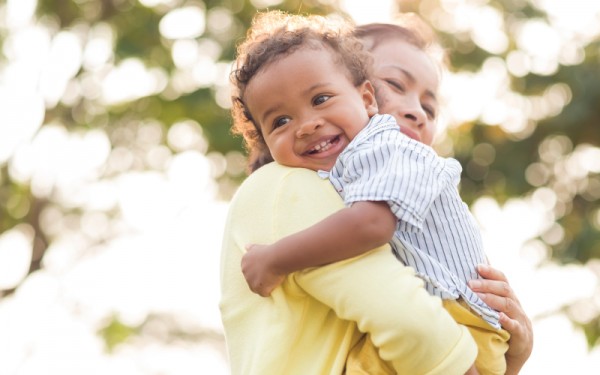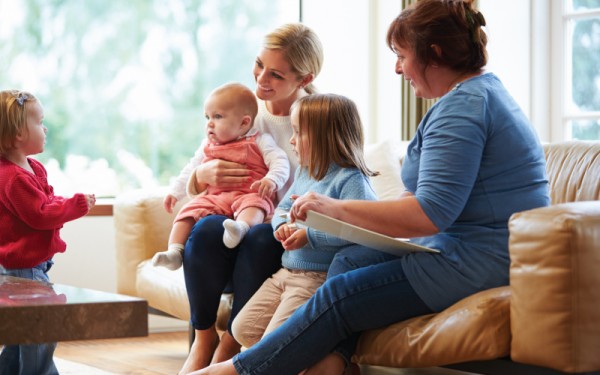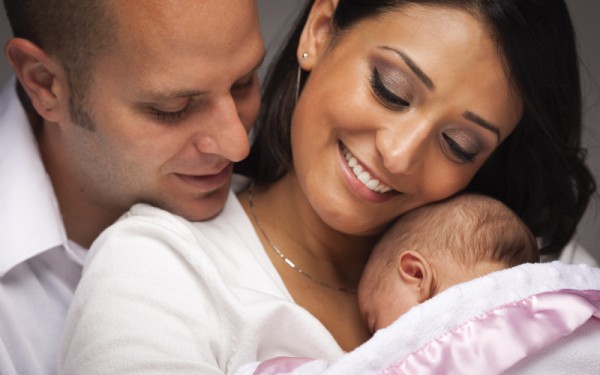You’re thinking about adopting a baby here in the U.S. In the adoption world, adopting a baby is called “Domestic Infant Adoption.” Adding a baby is a beautiful and life-expanding way to build your family. Sometimes, however, adopting a baby can seem like a pretty overwhelming process. That’s why we’ve put together this slideshow for you about baby adoption. Adopting a baby is something YOU can do. Every baby deserves a loving home. Over the next several slides, we’ll cover the basic steps in a domestic infant adoption, how to adopt a baby.
Are you and your partner ready to start the adoption process? Visit Adoption.org or call 1-800-ADOPT-98 to begin your adoption journey. We have 130+ years of adoption experience and would love to help you.

Domestic Infant Adoption
“I don’t know why they say ‘you have a baby!’ The baby has you.” – Gallagher
Babies! Tiny little fingers and toes. Shiny eyes. Toothless grins. Little fat rolls on arms. Babies make life so much more complicated– and yet, at the same time, boil it down to a state of utter simplicity.
In your heart you know that becoming a parent is the right choice for you. You are ready to love unconditionally. You’re here because you’re wondering if domestic adoption is the right avenue to take as you work to grow your family.
As you’re making this life-altering decision, you may also want to study the guides for other types of adoption:

Cost of Adoption
“Love will find a way.” -Blessid Union of Souls
You’ve heard that adopting a U.S. baby can be expensive. And it’s true. Whether we like it or not, the cost of adoption services can play a major role in which type of adoption feels like the best for your family.
The average cost of a domestic infant adoption in the United States varies. Costs could be different based on which adoption agency you’re working with or if you’re working with an adoption attorney. So check with your adoption professional for more specifics related to cost.
Take heart! There are ways to make adoption affordable, for anyone on any budget. Some adoption agencies will charge fees based on a sliding scale or give grants, but even if yours doesn’t, there are other ways to afford adoption.

Grief
Many people choose domestic infant adoption because they have been unable to conceive a baby. Choosing to adopt means letting go of hopes and dreams you’d previously held and opening your heart to new possibilities and new dreams.
It’s important to be in a place, mentally and emotionally, where you are ready to do this. Grief over your infertility is something you should address openly and honestly with your adoption social worker. He or she should be able to help you identify ways to work through the process, if you haven’t already done so.

Paperwork
You’ve also heard that there are mounds and mounds and mounds of paperwork you’ll be required to complete as part of the adoption process. It’s true, there’s some paperwork, but it’s do-able, we promise. Just take it one piece at a time.
Start by finding a licensed social worker or adoption agency in your area to complete your home study. He or she will help you understand and organize all the paperwork you’ll be required to complete.
You can learn more about the home study process here.

Open Adoption
“He is mine in a way that he will never be hers, yet he is hers in a way that he will never be mine, and so together, WE are motherhood.” -Desha Wood, Birth Mother
Many people are initially uncomfortable at the idea of an open adoption. However, most infant adoptions completed in the United States are open, and we here at Adoption.com fully endorse that change. Why? Read on!

Why Open Adoption?
“My children, ages 4 and 5, can tell you who their birth parents are and which characteristics they inherited from each one. They can tell you where they were born and why they were placed for adoption. They can tell you the differences and similarities between their birth mother and their mother. They already know their story and have unlimited access to it. They know their roots.” -Lindsey Redfern, Adoptive Mom
Here are just a few reasons that open adoption is so important for your adopted child:
- Children need the sense of identity that comes from understanding their biological roots.
- Children benefit from hearing the story of why they were placed for adoption from the people who chose to place them.
- Children thrive when they are able to experience firsthand the love of the parents who are raising them– and the love of the parents who chose adoption for them.
You, too, can benefit from the open relationship. You will love being able to reach out and connect with the people who changed your life forever by entrusting you with their child.
Research has revealed that the benefits of open adoption extend to all parties involved in the adoption: birth parents, adoptees, and adoptive parents.

Myths about Open Adoption
Myth: The birth mom will take her child back if she knows where to find him.
Fact: Your child’s birth mom will have made a careful, painstaking decision to place him or her with an adoptive family. She will legally relinquish her legal rights to parenting her child.
Myth: Hearing about/seeing her baby will make it impossible for the birth mother to “move on.”
Fact: A mother never forgets her child. Hearing about/seeing the baby progress is one way to soften the loss.
Myth: Open adoption is confusing to children.
Fact: Children in open adoption relationships can very easily discern between their parents and their birth parents, just as they can discern between their parents and their grandparents or their parents and their aunts and uncles.

Nurturing the Open Relationship
We believe that a good open adoption is like a strong marriage. It requires lots of regular nurturing, open and honest communication, and a firm commitment, but it can be one of the most beautiful and important things in your life.
Hopeful adoptive parents sometimes don’t realize the magnitude of the commitments they’re making when they say, “Of course we’ll let you have any amount of contact you choose to have with your baby” or “The adoption will be as open as you want it to be.”
It’s important that you carefully consider–and then keep–the promises you make to your child’s birth parents.
Read more on the positive aspects of open adoption.

Adoption Professionals
Choosing the right adoption professional is a big decision and can make a world of difference for you during your adoption journey.
With Domestic Infant Adoption, you have two main choices in how to pursue a domestic infant adoption: employing the services of a private adoption agency or completing the adoption privately, using an adoption attorney.
In some states, you are required by law to use an agency to complete your adoption. Check out the adoption laws in your state. Bear in mind that if you are adopting a child from another state, you will need to comply with adoption laws that govern the use of professionals in both the state you’re adopting from and the state you live in.

Agency Adoptions
A good adoption agency will provide education, guidance, and support that will help you make informed decisions before, during, and after your adoption has been completed. They will provide a professional to complete your home study and will help match you with expectant parents who are making an adoption plan for their child. Many agencies provide counseling to both birth parents and adoptive parents as well as offer classes to help educate parents about topics such as choosing open adoption, parenting a child that was adopted, and building a multicultural family.
Learn more about how to choose an adoption agency.
Considering adoption? Let us help you on your journey to creating your forever family. Visit Adoption.org or call 1-800-ADOPT-98.

Private Adoptions
If you decide to pursue a private adoption, you will need to retain an adoption attorney to help you understand adoption laws and work through the legal aspects of placement and finalization. In private adoptions, the medical and legal expenses of the expectant mother generally become the responsibility of the adoptive parents. You may also need to pay for counseling for the expectant parents and possibly for housing and clothing during the pregnancy.
Costs for agency vs. private adoptions are generally comparable, but situations vary widely.

Find a Professional
So you’ve made the decision about whether you want to use an adoption agency or an adoption attorney to assist with the adoption process. Now how do you find the best agency or attorney for you?
1) Ask for referrals. Your doctor, your cousin, your friend, your counselor, or that extra-friendly lady at the grocery store may know of an amazing adoption professional and be able to point you in the right direction.
2) Read reviews of adoption agencies and attorneys in your area.
3) Compare various adoption professionals. (A binder or spreadsheet could be helpful here.) Call and ask questions and note their answers and your impressions in your binder. Check the make sure the agency is licensed and look for any complaints that may be pending against its licensure; find out if your agency has been accredited, and check with the Better Business Bureau for a rating on the business.
4) Connect with a caring adoption professional.

Adoption Facilitators
Adoption Facilitators are people who help match birth mothers with hopeful adoptive parents. These services, though expensive, can expedite the adoption process, but you should be aware that adoption facilitation is not legal in all states. Check out our wiki for more information about adoption laws in your state. Once the match is made, it’s up to you to either complete the adoption through an adoption agency or attorney.

Home Studies
A home study is the process by which a licensed adoption professional spends time getting to know in you in-depth in order to determine your eligibility to adopt.
There is a lot involved in a home study, including making visits to your doctor for a physical, getting fingerprinted for a criminal history background check, and meeting with a social worker in your home. You will be asked to answer a lot of questions about yourself, your childhood, your marriage (if you’re married), your neighborhood, and your opinions on child discipline. You’ll also need to provide your social worker with a list of people who can recommend you for adoption.
You don’t have to be perfect to adopt! Your house doesn’t have to be perfect for you to qualify to adopt! A home study professional is there to help you become a parent. S/he is not hoping to trip you up on some technicality that will exclude you from adopting. S/he is hoping to help you achieve your dream of adopting a baby. It’s essential that you be open and honest with your adoption social worker so he can get to know the real you and help you address your concerns and perceived shortcomings.

What is the point of a home study?
Your home study social worker will want to know a lot about you—from your finances to your medical history to your criminal history to your views on raising children.
You may feel that it is unfair that you have to go through this process, but it helps to look at it this way: your social worker is acting as the eyes and ears of your future child’s birth parents. Think of it from their perspective. If you had decided to place your precious baby with another family to raise and care for, wouldn’t you want to know everything about them? A birth parent wants to know—as much as she possibly can know—that the family she’s placing her baby with is a good one. That her baby will be safe. That her baby will be loved. Nothing can guarantee that, of course, but the home study is a safeguard put in place for her benefit.

Parent Profiles
Your adoption agency will have you put together a profile designed to introduce you to expectant parents who are considering placing their child for adoption. This profile will include photos of you, as well as a little information about your life, your reasons for adopting, and your parenting plans.
In addition to creating a profile with your adoption agency—or if you’re pursuing an independent adoption—consider creating a profile to post online on Adoption.com Parent Profiles.
Creating a profile on Adoption.com’s Parent Profiles allows you to easily share your story with those considering placing their child for adoption. Features like videos and photos, posts, Pinterest-like favorites, and recommendations and endorsements make it easy to create a profile as unique as you are, increasing the likelihood that you will stand out and connect with that right person.
Rich communication options like video chat and instant messaging make connecting easy. A mobile-responsive design means that you will never be out of reach.
What’s more, Adoption.com receives over 650,000 monthly visits, which means your profile will receive unparalleled exposure. You can even view and monitor your progress through a detailed statistics page.
This is your first impression on someone who is looking for a family they can trust with their baby, so you’ll want to spend some time making your profile look good.
Here are some hints:
- Try to provide a mixture of professional photos and snapshots.
- Professional images can be appealing as a first impression and snapshots can help provide insight into your day-to-day life.
- Pick images with good lighting and composition.
- Have someone proofread your profile for grammar, spelling, and clarity.
Consider taking the time to read these awesome articles about making the most of your adoption profile:
Tips for Creating a Successful Adoption Profile
Writing a Dear Expectant Parent Letter
Tips for Adding Quality Photos to Your Adoption Profile
5 Ways to Make Your Adoption Video Make Magic

It can be intimidating to look through the profiles of other hopeful adoptive parents, all of whom seem to be financially independent, highly educated, ecstatic about their marriage, owners of an immaculate home, and a favorite among their nieces and nephews.
Don’t get too caught up in all that. Try to represent yourself as honestly as possible. It may surprise you what it is about your profile that interests someone considering placement for their baby.
Take, for example, Andrew and Deanna. They were worried about including pictures of all of their dogs in their Parent Profile. (“People might think we’re crazy!”) They did it anyway—and a mother working at PetsMart saw their profile and knew they were the right parents for her daughter.
Networking
If you want to decrease your wait time for a placement, do some networking!
Tell everyone you know that you’re hoping to adopt. Announce it on Facebook and ask people to share your profile with others. Create an adoption blog that your friends can share. Consider including a note in your annual Christmas card letting your friends and family know you’re hoping to adopt.
You never know whose cousin’s friend’s sister-in-law might be considering adoption for the baby she’s expecting. Many people were matched with potential birth parents because they spread the word that they were hoping to adopt.
Consider utilizing the exceptional reach of Adoption.com by creating a Parent Profile. (And take a look at the Ultimate Package! It’s amazing.)
Here are some tips on using social media to promote your adoption.
Be sure to check out our adoption forums to ask questions from other adoptive parents.

Make a Connection
You will probably hear from a number of expectant parents before you make a placement match that works for your family and for the expectant parents. The relationship needs to feel good to both the prospective birth parents and the prospective adoptive parents. Many parents on both sides of the adoption report a sense of “just knowing” that the connection was there.
Once that match has been made, you can begin building the relationship with the woman or couple considering placing their child with you.
This is a very vulnerable time for prospective birth parents, and it’s important that you are careful to ensure that they are making this decision without outside pressure. Learn more about coercion in adoption and how to avoid it.
Birth Fathers
Sometimes expectant fathers are an active part of the adoption placement process; sometimes they’re not. Regardless, it’s important for you to be aware that they, too, have rights regarding the placement of their child.
If it is at all possible, it’s best for you to actively seek to obtain the consent of the birth father as well. Many states now have “Putative Father Registries” that allow men who believe they may be the father of a child to have a say in plans for that child. Your adoption agency or attorney will check the registry to make sure that no one has made a claim to paternity before the child is placed.
Of course, the best-case scenario is an adoption plan that involves him in the decision-making process and the opportunity to get to know him and his family.

Planning for the Birth
Before the baby is born, it’s important for the expectant parents and hopeful adoptive parents to sit down together and make a clear plan for what they hope to happen on the day the baby is born.
Be prepared to communicate your hopes, but understand that ultimately, the feelings of the expectant mother are the most important. This is a vulnerable and tender time for her. She should be able to identify key elements of the event, such as who will be present with her during delivery, who will cut the baby’s umbilical cord, who will hold the baby first, when the adoptive parents will be contacted, how much “alone time” time she plans to spend with the baby before placement, and more.
Encourage our hopeful child’s biological mother to openly and honestly express what she wants and support her in her decisions.
This is a great opportunity for both biological parents and adoptive parents to practice open and honest communication with one another.
Every birth is a miracle. Enjoy it.
Try to be as open as you can to last-minute changes in birth plans and also be ready to give your baby’s biological parents all the time they need with their baby. Keep your visits short. This time in the hospital is usually a special and sacred time for all new parents, but especially for those who may be placing their child for adoption. Use empathy and listen to your heart.
Your emotions will likely be all over the place. Emotions may range from feeling like you don’t fit in at the hospital to anxiety to pure joy to lack of control to unconditional love. Take a deep breath. This is the day you’ve been waiting for as well.
To prepare for the big day, learn about the 5 Things Hopeful Adoptive Parents Should Never Do at the Hospital.

Placement
“Love can change a person the way a parent can change a baby- awkwardly, and often with a great deal of mess.” – Lemony Snicket, Horseradish
This is the day you get to bring your baby home! This is a bittersweet day with lots of tears on all sides. Be prepared for your heart to grow three sizes.
Failed Adoption Placements
Even with your baby nestled under a blankie in a bassinet next to your bed, his or her birth parents may not have yet legally consented to the adoption. Each state requires different waiting periods after the birth before the parents sign the relinquishment paperwork. Depending on where you live, this time period will range from 24 hours to two weeks.
Check out the adoption laws in your state.
A failed placement is when a child has been placed with adoptive parents but, for whatever reason, the legal paperwork cannot be obtained that would allow the adoption placement to proceed.
A failed adoption can feel like the end of the world, but you can make it through your grief. Take time to grieve and to heal. Keep hope alive in your heart and be forgiving.
Finalization
“Getting a burp out of your little thing is probably the greatest satisfaction I’ve come across. It’s truly one of life’s most satisfying moments.” – Brad Pitt
Finalization is the day when the baby becomes legally and bindingly a part of your family. You’ll attend a court hearing to complete this process.
The time period between placement and finalization can vary from a few weeks to several months to half a year. Again, this depends on your state’s regulations.
During the gap between placement and the finalizing of an adoption, you’ll have a bit more paperwork to complete and your adoption caseworker may come to visit a time or two to make sure everything is going well.
To find more help in preparing to parent your new child, you can review this list of recommended reading on adoption.

You’re a family.
